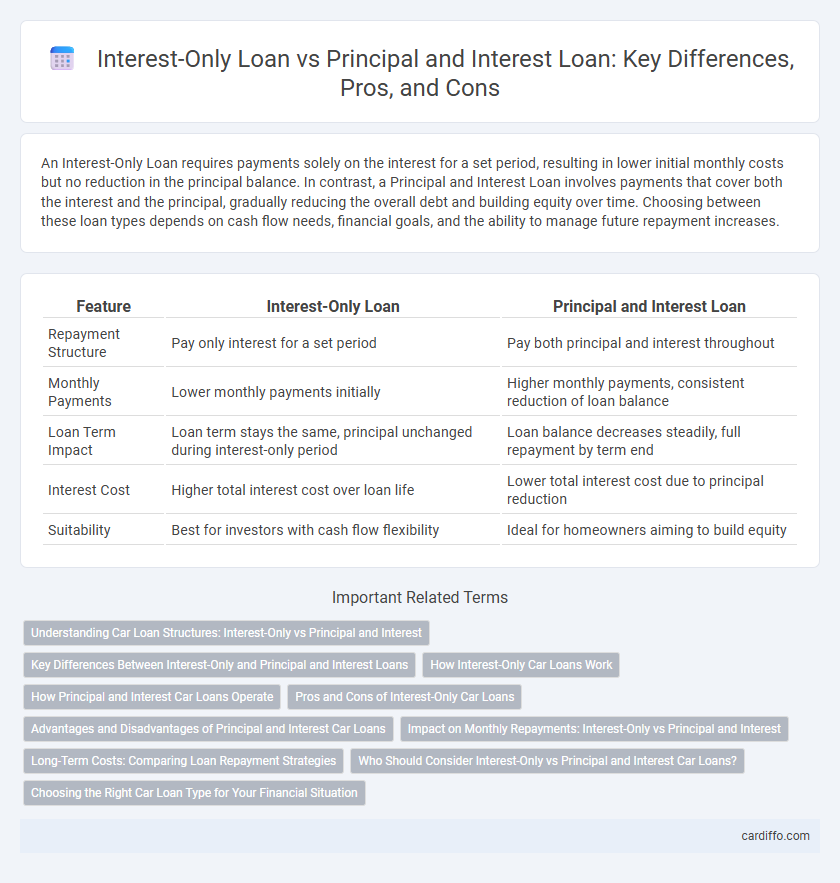An Interest-Only Loan requires payments solely on the interest for a set period, resulting in lower initial monthly costs but no reduction in the principal balance. In contrast, a Principal and Interest Loan involves payments that cover both the interest and the principal, gradually reducing the overall debt and building equity over time. Choosing between these loan types depends on cash flow needs, financial goals, and the ability to manage future repayment increases.
Table of Comparison
| Feature | Interest-Only Loan | Principal and Interest Loan |
|---|---|---|
| Repayment Structure | Pay only interest for a set period | Pay both principal and interest throughout |
| Monthly Payments | Lower monthly payments initially | Higher monthly payments, consistent reduction of loan balance |
| Loan Term Impact | Loan term stays the same, principal unchanged during interest-only period | Loan balance decreases steadily, full repayment by term end |
| Interest Cost | Higher total interest cost over loan life | Lower total interest cost due to principal reduction |
| Suitability | Best for investors with cash flow flexibility | Ideal for homeowners aiming to build equity |
Understanding Car Loan Structures: Interest-Only vs Principal and Interest
Interest-only car loans require payments solely on the accumulated interest, resulting in lower monthly installments but no reduction in the loan principal during the interest-only period. Principal and interest loans combine payments toward both the loan amount and interest, ensuring gradual principal reduction and eventual full loan repayment. Choosing between these structures impacts budget management, loan term length, and total interest paid over the life of the car loan.
Key Differences Between Interest-Only and Principal and Interest Loans
Interest-only loans require borrowers to pay only the interest for a set period, resulting in lower initial monthly payments but no reduction in the principal balance during that time. Principal and interest loans involve repayments covering both the principal and the interest, gradually reducing the loan balance and building equity over the loan term. The key difference lies in payment structure and long-term cost, with interest-only loans typically having higher overall interest expenses due to delayed principal repayment.
How Interest-Only Car Loans Work
Interest-only car loans require borrowers to pay only the interest on the loan amount for a predetermined period, typically 1 to 5 years, resulting in lower monthly payments initially. After the interest-only term ends, repayments increase as borrowers must start paying both principal and interest, often leading to higher monthly expenses. This loan structure benefits those seeking lower initial payments or expecting increased income in the future but involves paying more interest over the loan term compared to principal and interest loans.
How Principal and Interest Car Loans Operate
Principal and Interest Car Loans require borrowers to make monthly payments that cover both the loan principal and the accrued interest, gradually reducing the total debt over the loan term. Each installment consists of a portion allocated to the principal balance and a portion covering the interest charged, ensuring steady equity buildup in the vehicle. This repayment structure contrasts with Interest-Only Loans, where principal remains unchanged until the loan term ends.
Pros and Cons of Interest-Only Car Loans
Interest-only car loans offer lower initial monthly payments, improving short-term cash flow but do not reduce the loan principal during the interest-only period, potentially resulting in higher overall interest costs. Borrowers benefit from flexibility and affordability early on but face the risk of large payments later when principal repayment begins. This loan type suits those expecting increased income or planning to sell the vehicle before principal repayment starts.
Advantages and Disadvantages of Principal and Interest Car Loans
Principal and interest car loans require regular repayments that cover both the loan amount and accumulated interest, providing a clear timeline to full ownership of the vehicle. Advantages include predictable monthly payments and faster loan payoff, which reduces overall interest costs and builds equity in the car. Disadvantages involve higher initial repayments compared to interest-only loans, which may impact monthly cash flow, especially for borrowers with tight budgets or fluctuating income.
Impact on Monthly Repayments: Interest-Only vs Principal and Interest
Interest-only loans result in lower initial monthly repayments as borrowers pay only the interest, deferring principal reduction until the interest-only period ends. Principal and interest loans have higher monthly repayments since each payment includes both the interest and a portion of the loan principal, accelerating debt payoff. Choosing an interest-only loan can provide short-term cash flow relief, while principal and interest loans reduce total interest paid over the loan term.
Long-Term Costs: Comparing Loan Repayment Strategies
Interest-only loans typically result in lower initial monthly payments but can lead to higher long-term costs due to accrued principal balance. Principal and interest loans require higher monthly payments but reduce the loan balance over time, minimizing total interest paid. Evaluating the total repayment amount over the loan term highlights the cost efficiency of principal and interest loans compared to interest-only loans.
Who Should Consider Interest-Only vs Principal and Interest Car Loans?
Interest-only car loans suit buyers prioritizing lower initial payments, such as investors seeking cash flow flexibility or individuals anticipating increased income later. Principal and interest loans are ideal for those aiming to build equity steadily and reduce overall debt faster with consistent repayments. Understanding financial goals and cash flow needs is crucial in choosing between these loan types.
Choosing the Right Car Loan Type for Your Financial Situation
Selecting the right car loan hinges on understanding the difference between interest-only loans and principal and interest loans. Interest-only loans offer lower initial payments by requiring only interest during the early term, suitable for borrowers seeking short-term cash flow relief. Principal and interest loans gradually reduce the loan balance, making them ideal for those aiming to build equity and pay off the vehicle faster.
Interest-Only Loan vs Principal and Interest Loan Infographic

 cardiffo.com
cardiffo.com